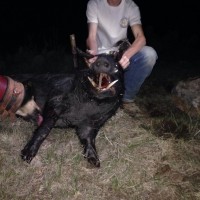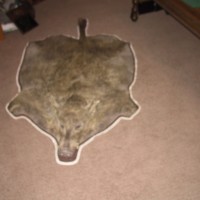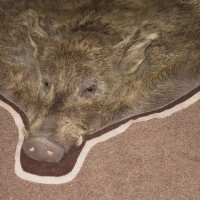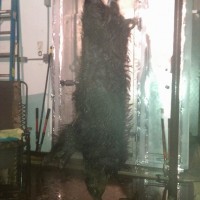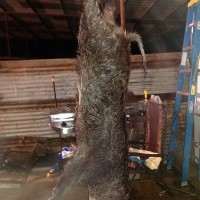Mike, I’ve had good success with smoking them. Since their wild, they tend to be on the lean side – or at least the few we did up.As for field butchering, keep it simple.
Hang by back legs and skin. Much easier to skin sooner than later.
We cut out the inner loins and back straps, clean off and vac seal in the Vac Master bags. I kept the ribs, so I wasn’t too concerned about being a little sloppy and leaving meat on them.
I left a lot of the front flanks on the ribs and cut out the front legs/shoulders. The lower of the legs are super tough meat and I don’t salvage a lot. I cut up from the inner side of the leg bone and debone the leg/shoulder. I don’t follow the “typical” butchering since I am just smoking and making pulled pork out of them. Vac seal and on the the hind quarters.
I do similar for the hind quarters. Only cutting more roasts. Had good success with wrapping these cuts in thick bacon/season, and slow cook in the crock pot with beer or red wine
I cut the rib off and cut in half – long ways so I get 4 racks of ribs.
I hate the neck. Tried a number of different things with it and haven’t done well. Can take a long time to trim all the tendons and crap out. We’ve ground it up and made jerky, added it to hamburger….just anything so it wasn’t wasted.
Just a suggestion on transporting meat. The investment in a GOOD vac sealer like the Vac Master 305 will pay for itself. The 305 runs about 250ish compared to the 170’s on other brands or smaller units. The seal strip is wider and the vacuum pump is much more heavy duty. Stay away from the Foodsaver bags – they are over priced, thinner mil, and a single ply poly. The Vac Master bags are cheaper in cost, 2 ply poly with an inner design to allow much more air to be pumped out. By sealing your meat, you can pack in ice and keep your meat dry and not water logged by the time you get home.
Good Luck down there and let us know when dinner is served! 
